Google Workspace provides a deep bench of tools, from email to real-time messaging. A common hurdle teams face, however, is the "Google Group Chat" confusion. Understanding how Google Groups (for lists) and Google Chat (for messaging) are designed to work together is the key to unlocking a truly seamless workflow – and avoiding a major productivity trap.
What is a Google Group?
At its core, Google Groups a powerful mailing list and web forum. It’s the engine behind support@company.com or all-hands@startup.io. It excels at one-to-many email distribution, managing group permissions, and acting as a lightweight, archivable forum. It’s a tool for distribution and asynchronous discussion.
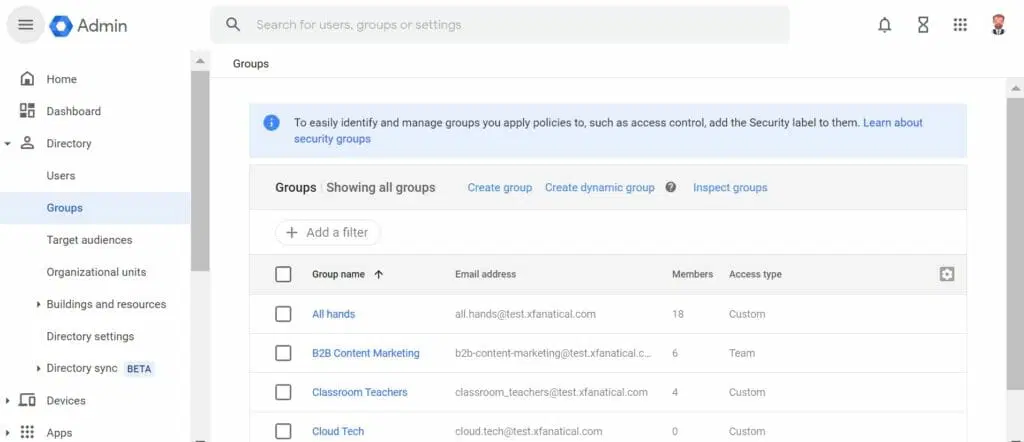
What it was never designed to be is a real-time chat application. It's the architecture of Web 1.0: a digital bulletin board, not a war room.
Does Google Groups Have a Chat Function?
This is the critical disconnect. No, Google Groups does not have a "chat" function in the way we understand it today. There's no green "online" dot, no real-time message stream, no "typing..." indicator.
The confusion is understandable, because Google's branding is often a labyrinth. The "chat" functionality lives in a completely different, albeit connected, product: Google Chat. You can link a Group to a Google Chat "Space," but you aren't "chatting in" the Google Group. You're just using the Group’s membership list to auto-populate a separate chatroom. It’s a directory, not a feature.
The Real Alternatives to "Google Group Chat"
This persistent gap between email (where work arrives) and chat (where work is discussed) is where the third-party ecosystem is innovating. The solution isn't to add another silo; it's to integrate the two.
1. Async notes and collaboration directly in Gmail (e.g., Gmelius)
The smartest solution isn't to flee the inbox; it's to upgrade it. Platforms like Gmelius are part of a new breed of tools that embed collaboration directly into Gmail. Instead of forcing your team to switch to a separate Chat app, this approach layers the collaboration on top of the work itself.

Teams can use @mentions and internal notes right on the email thread. You can have a full, Slack-like conversation with your team in a side panel that the client or sender never sees. The conversation stays permanently attached to the email, creating a single, indisputable source of truth.
You can assign an email as a task, set a deadline, and track it to completion, all from the inbox. This blends asynchronous email with synchronous chat, right at the point of work.
2. Dedicated messaging apps (Slack & Teams)
These are the obvious, 800-pound gorillas. Slack and Microsoft Teams have defined the market for real-time team chat. They are excellent for team-building, quick huddles, and fostering company culture.
Their flaw, however, remains the same as Google Chat's: they pull communication away from the email inbox. They are another "destination" that creates the very context-switching problem that drains productivity. (Cleverly, some platforms like Gmelius bridge this gap too, with two-way integrations that let teams manage shared inboxes from Slack, turning Slack channels into a functional inbox).
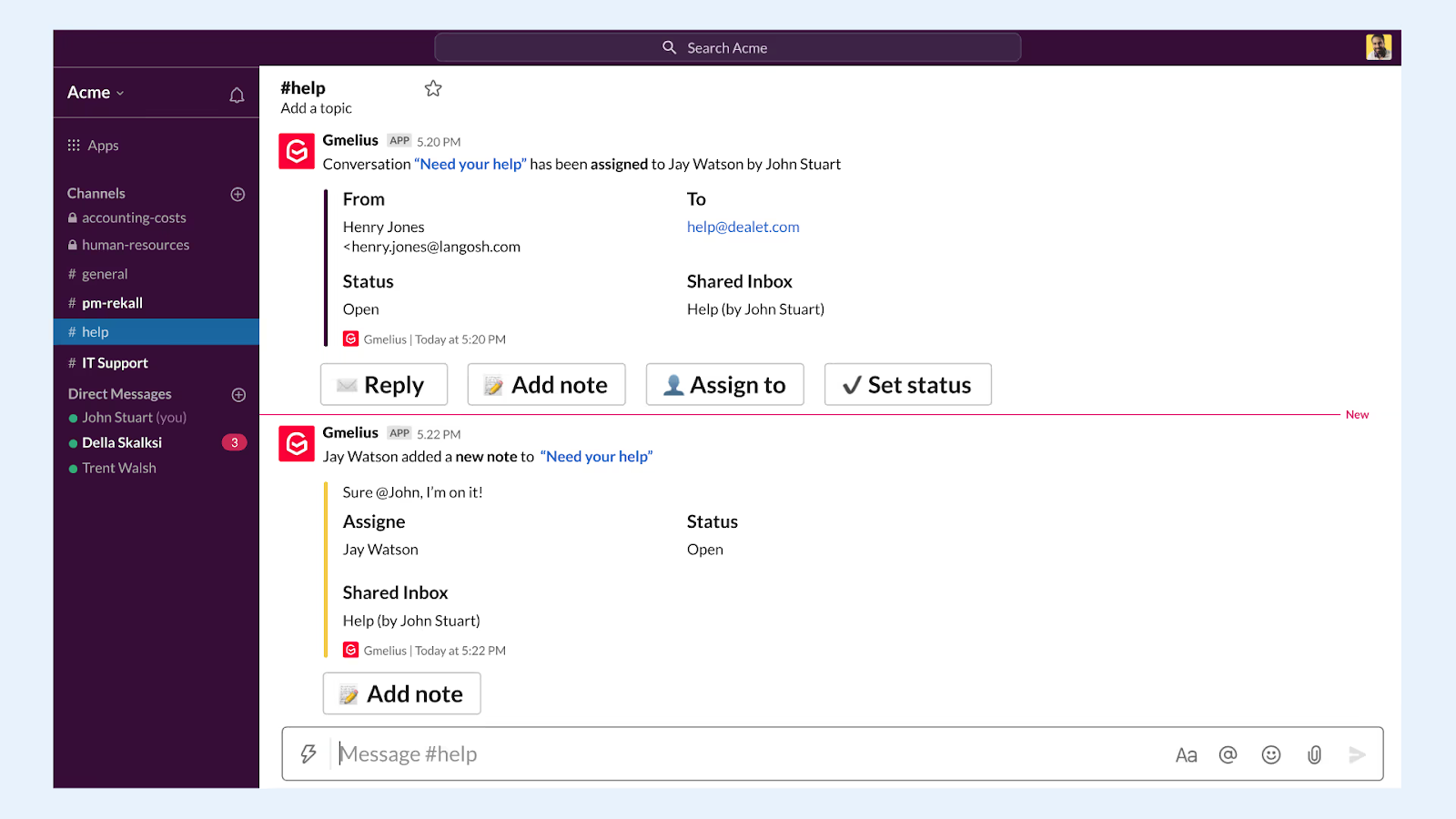
Why Google Groups Doesn’t Work as Chat
Trying to force Google Groups to behave like Slack is a recipe for operational chaos. It's like using a spreadsheet to write a novel. The entire architecture is wrong, and it creates friction that will grind your team's productivity to a halt.
First, it’s asynchronous by design
Groups is built on email. Every "message" is a separate email thread. This creates massive latency. You "post" a message to the group, and your team gets an email. They reply, creating another email. It’s slow, clunky, and utterly devoid of the rapid-fire, real-time "flow" that defines modern chat.
Second, it creates notification hell
Instead of a single, consolidated chat interface, every team member’s inbox is hammered with individual email notifications for every single reply, depending on their subscription options they choose. It’s the dreaded "reply-all" apocalypse, but institutionalized as a workflow. This isn't collaboration; it's a denial-of-service attack on your team's focus.
Finally, there's zero presence or real-time context
You can't see who’s online, who’s read a message, or who’s actively engaged. It’s a black hole of communication. Using Groups for chat isn’t just inefficient; it’s an active drain on productivity, burying teams in email clutter when they’re looking for a lifeline.
Also read: How Do Google Groups Work? Learn in 5 Minutes
Using Chat for Google Groups Instead
Google’s actual answer to Slack isn't Groups; it’s Google Chat. This is where the ecosystem attempts to stitch itself together. The "right" way to do this is to use Spaces within Google Chat. A Space is Google’s term for a persistent chatroom or channel, designed for projects and teams.
Here’s the hook: you can create a Space and, instead of manually inviting 50 people, you can simply add your Google Group (e.g., marketing-team@company.com). Google Chat then automatically syncs the Group’s membership list with the Space.
When a new person joins the Marketing Google Group (via HR onboarding, for instance), they are automatically added to the corresponding Chat Space.
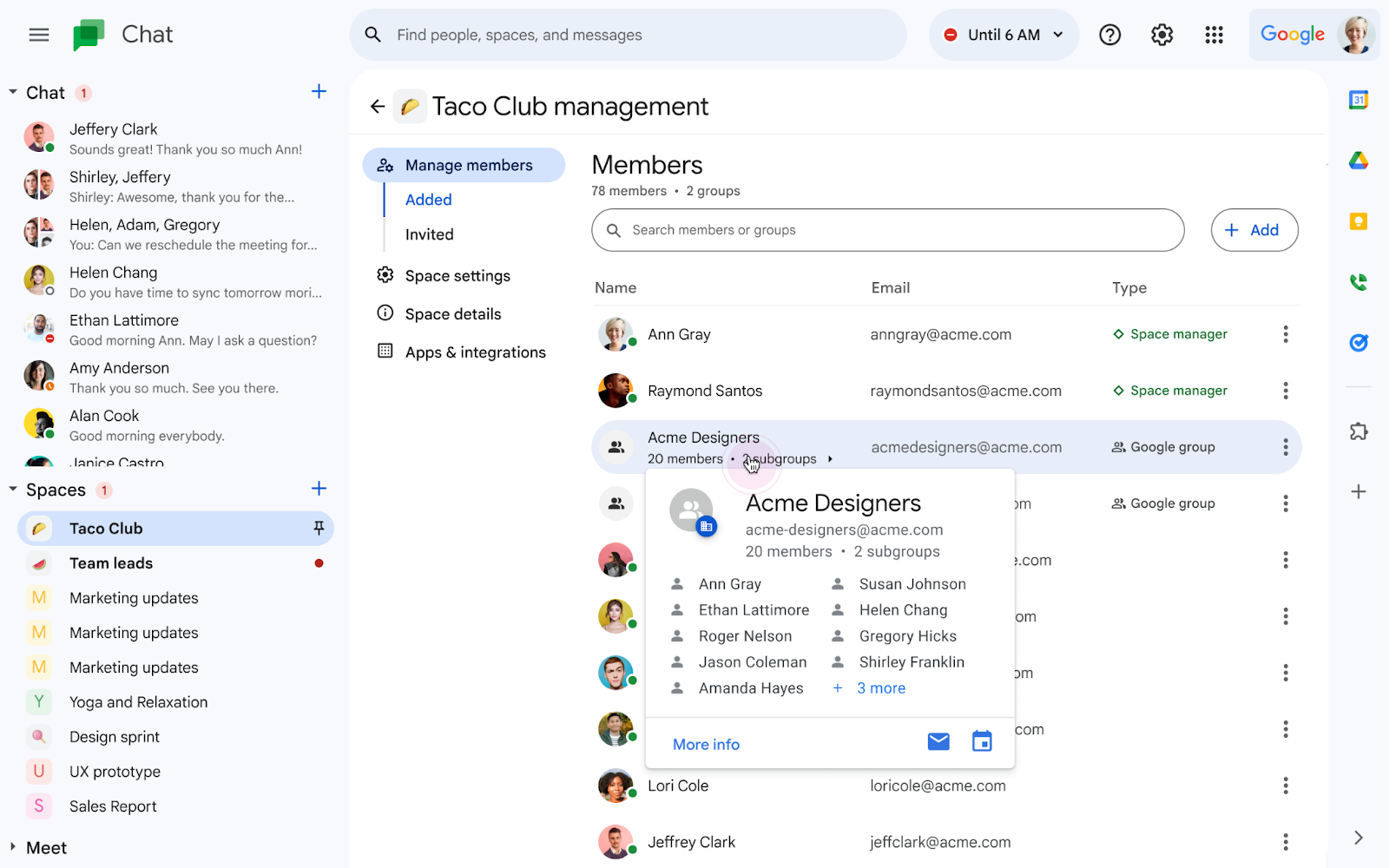
This finally gives you the chat functionality you were looking for: real-time messaging, file sharing, threaded replies, and emoji reactions. It successfully separates the fast, ephemeral conversation (Chat) from the slow, formal distribution (Groups). It's the intended workflow, and it's a huge step up from the email-only disaster... but it's not without its own deep-seated problems.
The Challenges of Google Chat for Teams
So, you’ve correctly routed your team to Google Chat. Problem solved? Not quite. Google Chat may be the intended tool, but it operates in its own frustrating silo, creating a new and profound set of productivity bottlenecks.
The single biggest problem is context switching. Your team now lives in two separate, non-integrated worlds. The "official" work (like an inbound client request to support@, a candidate application to jobs@, or a vendor invoice to finance@) still arrives in the Gmail inbox. But the discussion about that work happens in a Google Chat Space.
This means teams are constantly toggling between Gmail and Chat, copying and pasting information, and trying to connect a fast-moving chat conversation to a static email thread. The chat messages have no direct, actionable link to the specific email they’re referencing.
This digital whiplash breaks concentration and creates organizational drag. Studies have shown this constant app-switching can consume up to an hour per day, per employee.
Furthermore, Google Chat isn't designed for proactive, inbox-centric work. It’s a reactive communication tool, just like Slack. It can’t manage a shared inbox, assign ownership of an email, or track an email-based task to completion. It’s just... chat.
You can talk about the urgent client email, but you can't manage it from Chat. This forces teams into a broken workflow: the work sits in one place, the conversation about the work in another, and the accountability for the work is lost somewhere in between. That's why a platform like Gmelius makes a noticeable difference.
The Rise of Chat and How Google Groups Stacks Up
The collaboration market is white-hot, with employees now switching between apps over 33 times a day, according to a Lokalise report. This context-switching is a productivity killer. Google Groups, a tool meant for the Web 1.0 era, simply can't compete. It’s an email list. Google Chat is a decent Slack-lite, but it only widens the gap between communication and action. The real innovation isn't in creating another chat app; it's in finally connecting the chat to the work.
Start by downloading Gmelius for free.
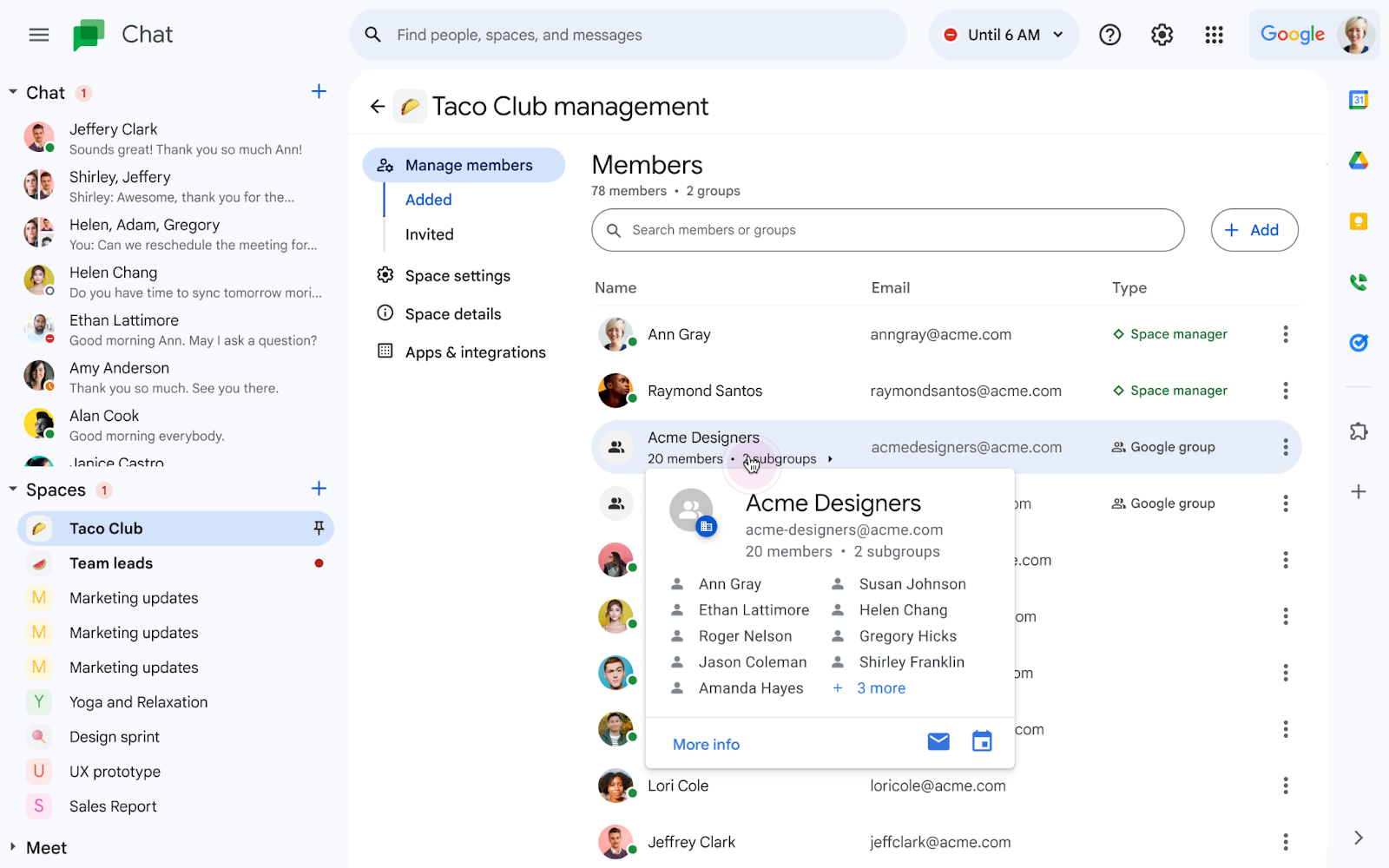


.avif)


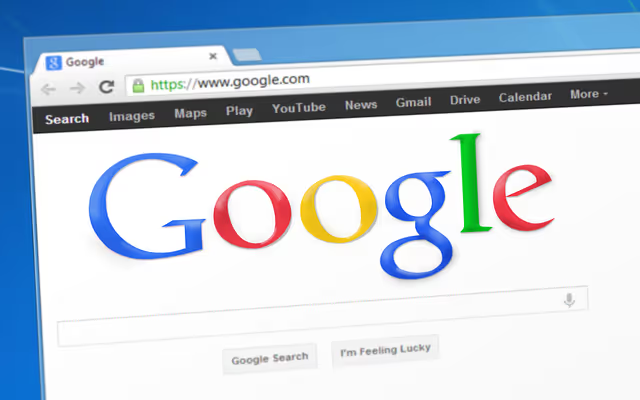
.avif)
.avif)